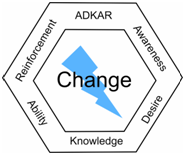ADKAR Model:
The Awareness, Desire, Knowledge, Ability, Reinforcement (ADKAR) Model (Figure) helps managers to
- recognize gaps within the change management procedure, and
- give effective training to the employees.
The Model supposes in which to make change successful, it should occur concurrently in both the business and people dimensions.

Figure: The ADKAR Model of Change
The Model is used to achieve the subsequent goals:
1 diagnoses employee resistance;
2 help employee transition by the change process;
3 create a successful action plan for personal & professional advancement during change; and
4 develop a change management plan for the employees.
Changes occur within two dimensions: the business dimension, and the people dimension. The business dimension involves the classical project elements (e.g., new processes & systems, organisational structure), while the people dimension of change deals along with the perception of change through the employees. The latter dimension is the most general purpose for the failure of any project or change. Thus, effectual management of the people dimension is most desirable. It needs managing five key phases that form a basis of the ADKAR Model.
Awareness : of the required to change
Desire : for participate and support the change.
Knowledge : for how to change (and what the change looks like).
Ability : to implement the change on a day-to-day basis.
Reinforcement : to remain the change in place.
The reaction of an employee to change & how s/he is viewed through the organisation will be directly affected through every of the five elements in the ADKAR Model. Thus, although implementing a main change in the organisation, awareness must be created between employees of the purpose for change. Desire to change at the employee level have to be addressed as resistance to change is a natural reaction. Since the change moves within implementation, it becomes imperative to establish knowledge about the change and the ability to implement new skills and behaviours. Once the change is in place, it requires to be reinforced and any movement backward to old behaviours should be prevented by constant dialogue & training.